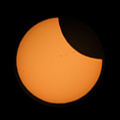
Next Hybrid Solar Eclipse: November 14, 2031
Next Annular Solar Eclipse: October 2, 2024
Next Total Solar Eclipse for North America: April 8, 2024
On this page: Intro - Solar Eclipse Types | Solar Eclipse Magnitude | Total Eclipse Phenomena | Resources | Reading Eclipse Diagrams
Total solar eclipses are the most exciting, if one happens to find theirself in the path of totality. This is the path that is made by the tiny shadow of the Moon when it blots out the Sun for a specific location. The lunar shadow moves from West to East, unlike most objects in the sky. The umbral path is up to 166 miles wide (267 km) depending upon where the Sun, Earth, and Moon are positioned. It speeds across the landscape, covering up to 10,000 miles. Totality may last up to 7 minutes and 30 seconds, although most eclipses are of shorter duration. A total eclipse lasts several hours. The Moon first covers the edge of the Sun, moving across the disk until the brief the moments of totality begin. It always ends too soon, as the Moon slowly uncovers the Sun's bright disk.
There are 4 types of Solar eclipses:
A total solar eclipse will occur when the Moon's shadow totally covers the Sun. In an annual eclipse, the Moon is farther away and so smaller, so that its shadow doesn't completely cover the Sun but leaves a bright sunny ring around a black center. In a partial eclipse, the Moon only covers a portion of the Sun. The rarest of all solar eclipses is the hybrid solar eclipse when the Sun is totally covered at some locations, but is annular at other locations along the eclipse path.

A total solar eclipse can only occur during a new moon when the Moon is in front of the Sun and the entire surface facing the Earth is not illuminated by the Sun. In a total solar eclipse, the Sun and the Moon are perfectly aligned as viewed from a location on the surface. When this happens, darkness comes on Earth wherever the Moon's full shadow falls. There is a limited area that the shadow of the Moon will fall on Earth.
A total solar eclipse has a central line where the central axis of the Moon’s shadow cone traverses Earth's surface. The track on the Earth's surface produced by the shadow axis is called the central line of the eclipse. This term may be called, "center line", "central line", or "centerline". The duration of a total or annular eclipse is longest on the centerline. The path is subject to the curvature of the Earth's surface, of course.
For any total solar eclipse, there is a limited area of the Earth's surface that is crossed by the Moon's shadow. The Moon's shadow is called the umbra, and the distance on Earth the eclipse shadow travels is called the umbral path or path of totality. It is never more than about 100 miles wide and 10,000 miles long, these figures vary for each individual eclipse. (This is about 160 km by 16,000 km) In contrast, the large shadow of the Earth covering the Moon during a lunar eclipse allows a much greater region of the Earth's surface to experience the darkening of the Moon's disk.
Total solar eclipses have five stages:
First contact is when the partial eclipse begins. The Moon’s shadow moves over the Sun's disk. This is also called first bite because it looks like the Moon has taken a bite out of the Sun. This stage is abbreviated C1.
At second contact the total eclipse begins. The Moon covers the entire disk of the Sun. Observers in the path of totality path may be able to see the diamond ring effect and Baily's beads that appear just before totality. This is the only time it is safe to look at the Sun. This stage is abbreviated C2.
Totality and maximum eclipse: The Moon completely covers the disk of the Sun. Only the Sun's corona is visible. This is the most dramatic stage of a total solar eclipse. At this time, the sky goes dark, temperatures can fall, and birds and animals often go quiet. The midpoint of time of totality is known as the maximum point of the eclipse. This stage is abbreviated MAX.
At third contact the total eclipse ends. The Moon starts moving away, and the Sun reappears. . Observers in the path of totality path may be able to see Baily's beads and the diamond ring effect just after totality ends. Now all sun protection must be used for eyes and sensitive instruments. This stage is abbreviated C3.
Fourth or Last contact occurs when the partial eclipse ends. The eclipse ends when the Moon leaves the Sun's disk. I like to call this last bite. This stage is abbreviated C4.
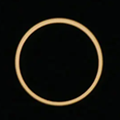
In an annual eclipse, the Moon is farther away and so smaller, so that its shadow doesn't completely cover the Sun but leaves a bright sunny ring around a black center. It can be very exciting to watch the eclipse using a projection method. At no time can the annular solar eclipse be observed without proper eye protection. Like a total solar eclipse, annular eclipses also have a centerline on the umbral path. If you are fortunate enough to be near the centerline, the Moon will cross the Sun's disk creating a perfect ring in the sky during the moment of mid-eclipse.

In a partial eclipse, the Moon only covers a portion of the Sun. This is the most common of all solar eclipses. A partial solar eclipse occurs if the Moon passes between the Sun and Earth but they are not aligned perfectly. The Moon's shadow will only cover a part of the Sun's disk. A solar eclipse might only be partial all over the world, but total eclipses can be seen as partial eclipses in a wide area surrounding the track of any solar eclipse. These locations are too far away from the centerline to see the total phase. Outside of the central umbra path the partial eclipse will usually cover thousands of square miles, especially those eclipses that occur away from the poles.

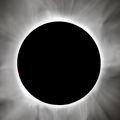
The rarest of all solar eclipses is the hybrid solar eclipse when the Sun is totally covered at some locations, but is annular at other locations along the eclipse path. During the eclipse, the Moon is moving in its orbit. The dark umbra (shadow) moves along a narrow path on Earth’s surface. The Earth’s surface, is curved and its radius is about 6,500 kms, therefore a person standing with the Sun and Moon above their head is closer to the eclipse than a person standing near the edge. The similar size of the Sun and the Moon is so close, that even this difference has an effect!
Fortunately, an exciting hybrid eclipse is coming to the southern hemisphere in April 2023.
As the central path of the eclipse reaches Earth, the eclipse starts out as an annular eclipse as the disk of the Sun is covered ~99.6 percent. This occurs in the south Indian Ocean a bit north and west of the Kerguelen Islands. As the Moon's shadow dashes across the ocean, it becomes a total eclipse about 435 miles later. The track makes landfall on the continent of Australia, landing at Ningaloo, crossing the Cape Range National Park and brushing past Exmouth. Here totality lasts 55 seconds. The eclipse path crosses the Timor sea, at Timor-Leste and moves on to Papua where the eclipse lasts about 1 min 10 sec. But soon the time of totality begins to decrease, so that it lasts only 1 min 8 sec when it leaves the island and only makes landfall at two small islands before it continues across the Pacific Ocean. There is no other landfall and the track becomes annular again south of the Marshall Islands. Before sunset this eclipse becomes a partial eclipse as the path continues across the sea.
A new tab will open on your browser for all links in this section
Use this link to download the Orthographic Map for the Hybrid Solar Eclipse of 2023 Apr 20 at Eclipsewise.
Hybrid Solar Eclipse of 2023 Apr 20 Interactive Google Maps - Xavier M. Jubier
Hybrid Solar Eclipse of 2023 Apr 20 from Eclipsophile (Find the weather here and outlook for this eclipse.)
Solar eclipses are discussed using magnitudes that measure of the extent of an eclipse. In a solar eclipse, the magnitude is the fraction of the Sun's diameter that is covered by the Moon. If the eclipse is total, magnitude is replaced by the ratio of the apparent diameters of the Moon and Sun, which is always 1.00 or more during totality. It is a ratio of Sun/Moon diameters and is not the same as eclipse obscuration. When the solar eclipse magnitude is 50 percent only about 40% of the solar surface is obscured.
If you've never experienced totality, this stage of a total solar eclipse will surprise and delight you. As the eclipse begins, when the Moon takes the first bite out of the solar disk, there is no discernible effect without the aid of a magnifying instrument. As more of the solar disk is obscured, the temperature will begin to fall, although it is most notable when the Sun is about half hidden. Although the day still seems bright, a loss of light and heat becomes increasingly evident. The early and later stages of the eclipse will present a lot of bright sunlight, so remember your sunscreen if you want to observe the entire 2.5 hour show.
As it begins to grow dark, the bright planets will begin to appear. For those who watch the dance of the planets, the familiar evening or morning planetary lineup will be revealed, starting with Venus, Jupiter, Saturn, even Mars or the distant gas giants that aren't possible to detect without magnification. Even 1% of the sun's rays can cause blindness, so please don't stop using protection until every direct glimmer of the Sun's surface is hidden.
Diamond Ring
As the Moon moves to cover the entire disk of the Sun, the corona is beginning to appear. Now the Sun's corona forms a ring around the Moon. The ring around the Moon and the last tiny bit of the Sun's disk gives the appearance of a diamond ring. This the signature sight of upcoming total eclipse and many photos of them have been published.
Bailey's Beads
The phenomenon occurs about 3 seconds before totality begins and again after totality, Baily's beads are little bead-like blobs of light at the edge of the Moon. The "beads" of light appear because the gaps in the mountains and valleys on the edge of the Moon's disk allow sunlight to pass through in some places but not others. The relief is significant enough that Earth-based observers are treated to a beautiful sight. Only one side of the disk will show Bailey's Beads. As quickly, as they appear, Baily’s beads vanish when totality begins or ends. Baily beads were first noted by Edmond Halley, but are named after Francis Bailey after the explanation of them to the Royal Astronomical Society.
Solar Chromosphere
This layer of the Sun’s atmosphere appears as a reddish glow that may only be seen for a few seconds after the diamond ring disappears. The word chromosphere means circle of color. It is very tenuous, and quite hot ~25000K. It is in the chromosphere that solar prominences occur. These are giant plumes of gas that glow in a bright magenta color. They are quite spectacular during totality.
Solar Corona
Like the chromosphere, the Sun's corona is only visible during the totality of a solar eclipse or by using special instruments. The corona surrounds the Moon's silhouette when the Sun's disk is totally covered. The word corona means crown and what a crown it is! Extending from the Sun for millions of kilometers (miles), it appears like a white mist that surrounds the eclipsed solar disk. We think of the sun as hot, but it is the solar corona where our life-giving Sun really heats up. Temperatures in the corona have been clocked up to 10 million K degrees. Here is where the ion plasma solar flares reach out from the Sun’s disk and speed through the solar system. (Flares originate below the photosphere surface.)
Shadow Bands
Shortly before and after totality, plain surfaces may show wavy lines of alternating light and dark moving across them, similar to the effect of light and dark waves of sunlight reflecting at the shallow bottom of a body of water. The shadow bands are the result of the light emitted from a thin sliver of the solar surface being refracted by Earth's atmosphere. These effects are caused by the motion of the water or atmosphere. A total eclipse that occurs on a windy day may not exhibit shadow bands. Total eclipse observers spread a large white sheet on the ground in an attempt to observe the effect just before or after totality.
Solar Prominences
During totality, solar prominences at the edge of the Sun's limb can be seen. Solar prominences are anchored to the sun, they are loops that rise up from the surface and fall back again. The looped material is plasma, that is, a hot gas made of electrically charged hydrogen and helium. The plasma flows along magnetic fields generated inside the Sun. A prominence will form in about a day, and stable prominences may last several months and loop hundreds of thousands of miles into space. Prominences appear to be a reddish color, almost magenta, and they stand tall over the Sun's limb. Images taken during eclipses showing prominences can help to identify individual eclipses due to temporary appearance of solar prominences.
Animal Behavior
Animals and plants can also be deeply affected by the dropping light level. Most of them respect the day/night cycle and have instinctive behavior that they follow on a daily basis. During an eclipse, some of animals will begin to exhibit their evening behaviors. Some night blooming flowers have been noted to give off their scent. Work horses may refuse to carry out their regular work tasks, some are reported to actually lie down in the middle of their assigned tasks. Cows have been noted to arrange themselves in a circle, each cow facing outward.
It is funny that many accounts of total solar eclipses describe scenes of bedlam among primitive natives. Some of them have been reported to make a lot of noise to scare away the frightful spirits that have caused the Sun to vanish. Having been to a couple of total eclipses and watching videos from countless others, I must remark that “modern” people make as much noise and get just as crazy during totality as well! The particular eclipse that occurred on August 21, 2017 was viewed by millions throught the 12 states along the U.S. of A. path. Listening to a few of the video recordings made during that eclipse tell the same story.
There is nothing like a total solar eclipse, darkness in daytime. During totality, it is possible to look directly at the Sun. And only during totality! Even a small fraction (1%) of the solar disk can burn out the human retina. So as always, use proper filters and take care during an eclipse. One more thing, if you stay outside during the entire eclipse, be sure to wear sunscreen. I've been burnt more than once during eclipses!
Note: These are off-site links that will open an new window
Mr. Eclipse Solar Eclipse primer
Upcoming Eclipses of the Sun and Moon
Mr. Eclipse is Fred Espenak, a retired NASA employee who maintained NASA's eclipse pages for many years. The upcoming eclipse pages contain all the eclipses of the Sun and the Moon until October 2024 and links to detail pages of solar eclipses beyond that time frame. Here you will find information on all eclipses of the Sun and the Moon.
Solar Eclipses - from NASA's Eclipse Page
Explore Solar Eclipses - My NASA Data from NASA Langley
My NASA Data supports students and teachers of grades 3-12. It is devoted to Earth Science and data returned by NASA's missions
What Are Solar Eclipses? - from timeanddate.com
Interactive Google Maps - Solar Eclipses
Xavier M. Jubier is a french eclipse chaser who maintains the interactive Google map eclipse site. He is the inventor of solar/lunar eclipse Google Maps and Google Earth files, author of Solar Eclipse Maestro, Lunar Eclipse Maestro and Mercury Venus Transit Maestro. He has many pages covering the observations he has made and software available for download.
You may like:
Xavier M. Jubier - Site owner
Solar eclipse charts are available on the internet, but how are they read and what does each element mean. One major resource for eclipse diagrams on the web comes from Mr. Fred Espenak, who makes his charts available for use. Many astronomers count on Mr. Espenak's diagrams. Using the eclipse diagram for the Total Solar Eclipse of July 22, 2028, this will explain the elements as they appear on the chart.
The total solar eclipse of July 22, 2028 should be a very nice eclipse. The Moon less than 2 days away from perigee and so will be near its largest. The Earth reaches aphelion on July 3, this means that the eclipse circumstances are very favorable. This eclipse is favoring the continent of Australia just during the Winter season. This is an opportunity for folks in the northern hemisphere to visit Australia!
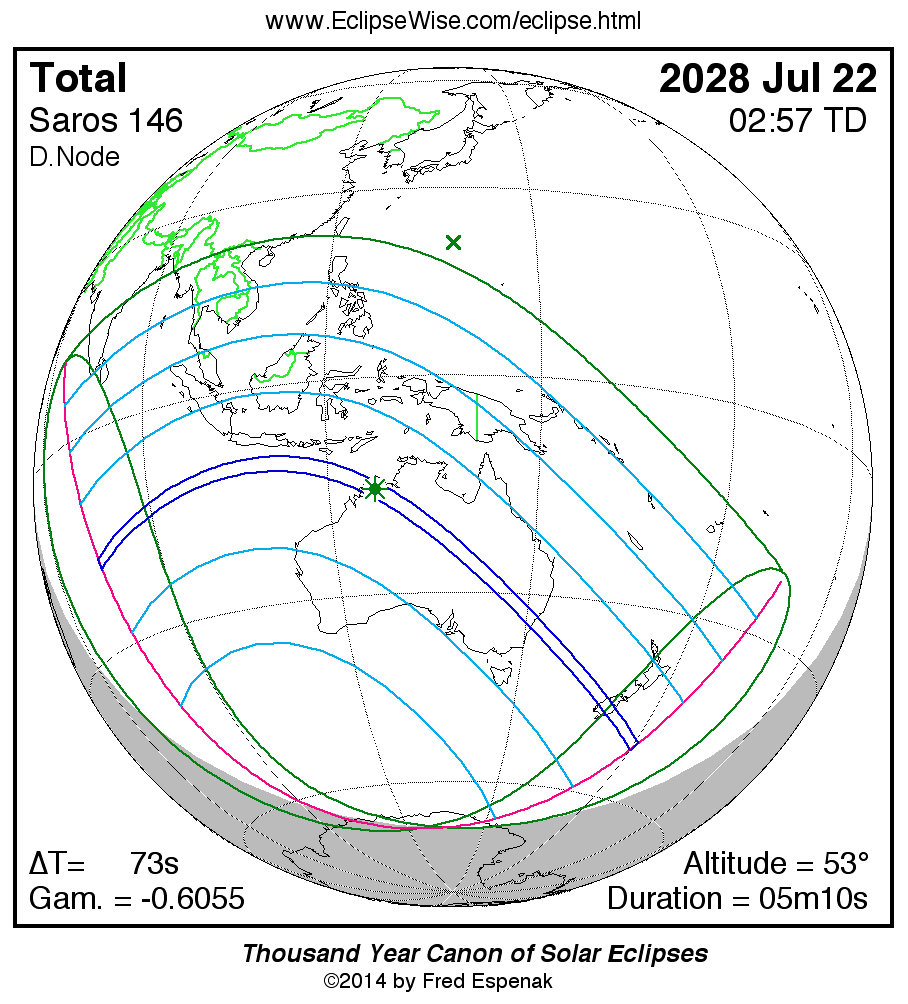
In bold letters at the top the type of eclipse and the date are in bold. This chart comes from Mr. Espenak's Five Millennium Canon of Solar Eclipses publication so we know that it means a solar eclipse. The eclipse comes from Saros 146 (See the explanation of the Saros Cycle if you don't know what that means.) It is an even number, and it has also been clarified on the next line where the D stands for descending node. The time 2:57 TD is the time of the greatest eclipse where totality will last the longest. Terrestrial Dynamical Time (TDT) or the more recent name, Terrestrial Time (TT) is based on UT (Universal Time) as corrected by atomic clocks.
Eclipse predictions are given in both Terrestrial Dynamical Time (TD) and Universal Time (UT). In this case the exact time UT is not given but the figure ΔT (delta T) is the number of seconds used to convert between DT and UT. The ΔT for this eclipse is 73.2 seconds.
The July 2028 total solar eclipse belongs to Saros 146. All eclipses in this series occur at the Moon’s descending node. The Moon moves northward with respect to the node for the next eclipse in the series, and gamma increases. Gamma represents the minimum distance from the axis of the lunar shadow cone to the center of Earth, based in units of Earth's equatorial radius. Whether gamma is positive or negative depends on whether the axis of the shadow cone passes north or south of Earth's center. If gamma is between +0.997 and -0.997, the eclipse is a central one, that means it is total, annular or hybrid.
The eclipse diagram is drawn on a orthographic projection map of Earth, the dark blue line that crosses the center of the figure represents the path of the eclipse centerline. The green colored sun in the center of the blue line represents the location where the total solar eclipse will last the longest, or greatest eclipse. In this case the longest duration is 5 minutes and 10 seconds. The line is blue because the eclipse is total, otherwise an annular eclipse shows a red central path. In the case of a hybrid eclipse, the line will change from blue to red when the central eclipse moves from total to annular. Note that the eclipse occurs along the path from the western side to the eastern side of the Earth. This is because the path represents the shadow of the Moon, not the actual direction objects appear to move in Earth's sky. The center line of the eclipse is always in the middle of the path.
The light blue lines that appear on either side of the central path indicates the percentage of the solar disk that is covered by the Moon in 20% intervals. Most of Australia is shown within the 80% coverage zone. The green X marks the sub-solar point, the geographic location where the Sun appears directly overhead (zenith) the time of greatest eclipse. At the bottom right, the Altitude of the Sun and Moon at greatest eclipse is 53 degrees. The Duration of 05m 10s also refers to greatest eclipse. Lastly, the curved red line represents the sunrise and sunset times. On left side of the diagram, the eclipse begins at sunrise. On the right side of the figure the eclipse ends at sunset.
Phases of solar eclipses have been broken down further as will be seen on the eclipse diagrams that have been prepared by Mr. Espenak and others. A breakdown of these events in simple terms follows, for more technical information, go to Fred Espenak's page or check with NASA.
| P1 - The instant the Earth touches the Moon's penumbra, partial eclipse begins. |
| P2 - The instant the entire Earth is in the Moon's penumbra. |
| P3 - The instant the Earth begins to exit the penumbra. |
| P4 - The instant the Earth leaves the penumbra, partial eclipse ends. |
| - - Note: Not all eclipses have P2 and P3 penumbral contacts. They only occur if the penumbral shadow falls completely within Earth's disk. |
| For central eclipses, the contact times of the Moon's umbra with Earth are defined as follows: |
| U1 - the Earth touches the Moon's umbra when total or annular eclipse begins. |
| U2 - The instant the entire Earth is in the Moon's umbra with Earth's limb. |
| U3 - The instant the Earth begins to exit the umbra. |
| U4 - The instant the Earth leaves the umbra when total or annular eclipse ends. |
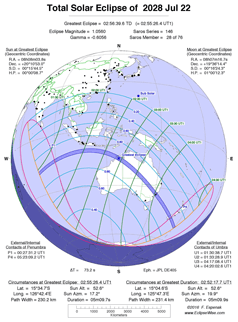
To get the most information and color figures the best way to find and print eclipse maps and figures, use the orthographic map prepared by Fred Espenak on Eclipsewise.com. This page is shown as a thumbnail to the right side of the page. All of the contact points shown above are given on this chart, as well as the circumstances of greatest eclipse and much more.
Don't try to use the image I posted here because it will not print well. The chart for the July 22, 2028 eclipse can be found at Orthographic Map of the Total Solar Eclipse 22 July 2028.
The instant of greatest solar eclipse is always at the geographic location that the Moon is directly over. For the observer located at greatest eclipse, the Sun and the moon will be on their meridian at mid-totality. Here is the greatest eclipse located in Australia at the time of the July 2028 eclipse.
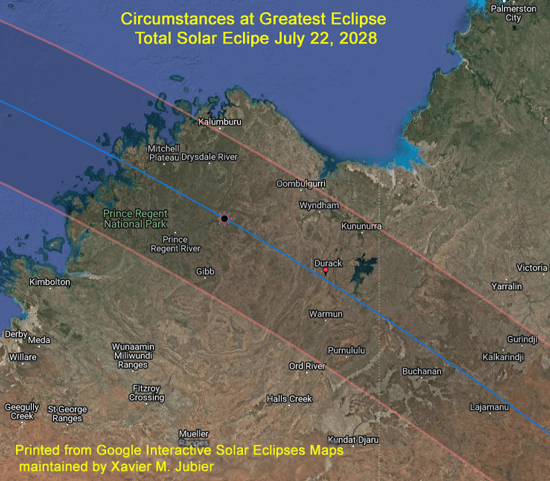
On this map that has been pulled from the Interactive Google map of the July 2028 total solar eclipse, the center line is clearly marked in blue with the outer red lines indicating the extent of the central solar eclipse. The figure of the Sun marks the location of greatest eclipse. From this image it can be seen that the instant of greatest eclipse occurs literally in the middle of nowhere. All told this will be a great eclipse for observers on the continent of Australia.
Investigate this eclipse further by going directly to the Interactive Google Map Total Solar Eclipse of July 22, 2028 - maintained by Xavier M. Jubier
A Caution from Astra:
NOTE: I cannot stress enough the importance of proper eye protection when viewing the sun! Only use approved solar filters. The best way to observe an eclipse is using a pinhole camera that projects the image of the Sun and Moon. However, one modern practice is to use cardboard "Sun Glasses" or even plastic glasses. Make sure that no light can penetrate the film that is used and discard any that have imperfections in the coating. Gazing at the Sun without adequate protection can damage your eyes for life. The sun can even damage equipment that is not appropriately protected. One slip and you could see "sun spots" (caused by nearly instantaneous eye damage) for the rest of your life!! Find out how to protect yourself on the Solar Eclipse Safety page.
| Greatest Eclipse | Greatest Duration |
|---|---|
|
Lat. 25° 17’ N Long. 104° 8.3’ W Duration 4m 28.1s |
Lat. 25° 55’ N Long. 103° 31’ W Duration 4m 28.2s |

Please feel free to point others to this URL. Images on this page are NOT in the public domain in the U.S.A. The text on this page is copyrighted, ©2023, by the author, Dawn Jenkins, and is NOT released into the public domain. It should not be copied to another site without permission or otherwise published without contacting and crediting the author. Seriously, just ask!
Please read the copyright statement linked below. For more information and other permissions use Astra's Contact Page